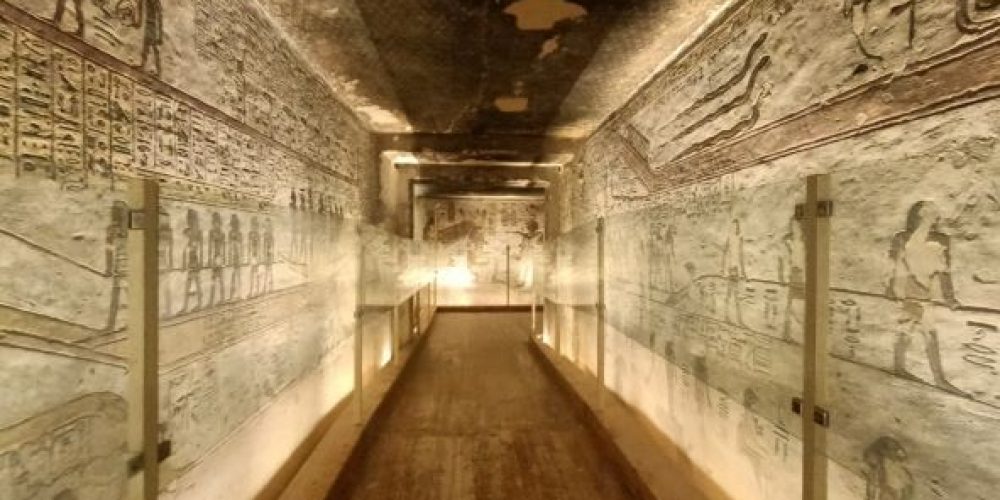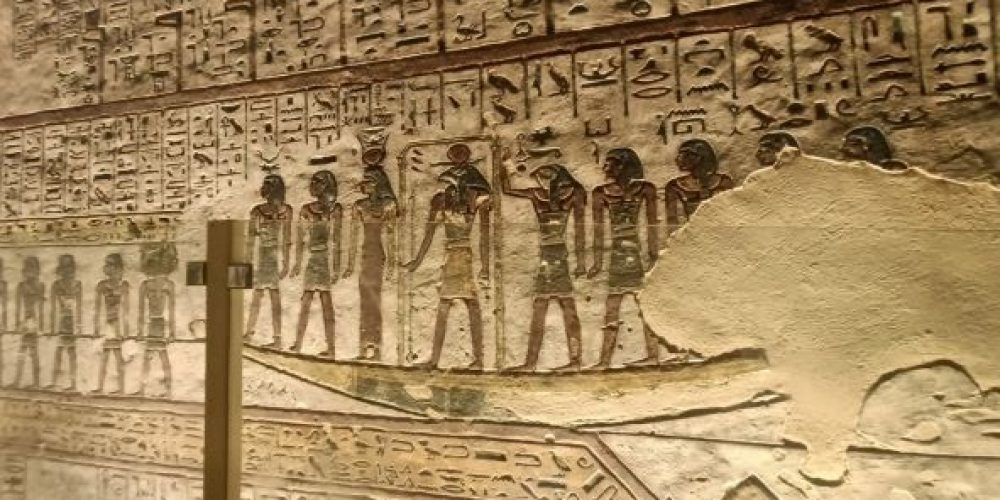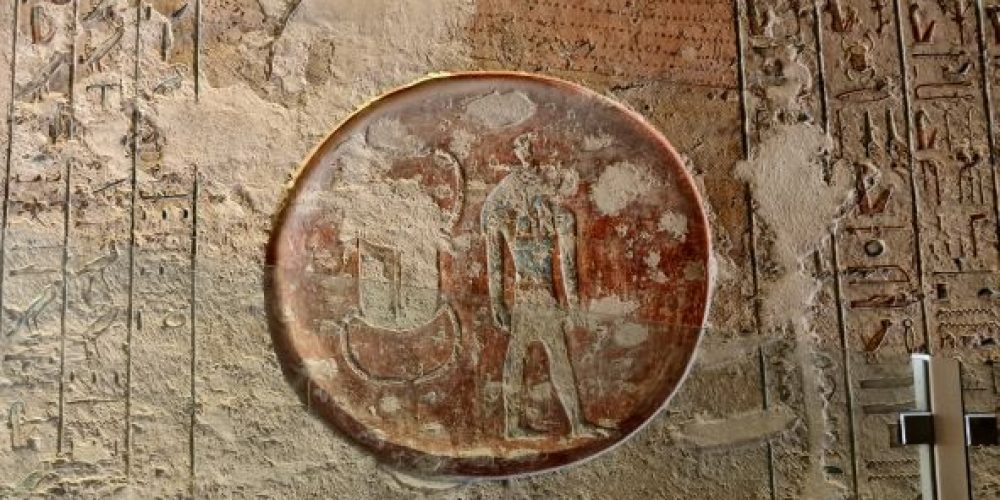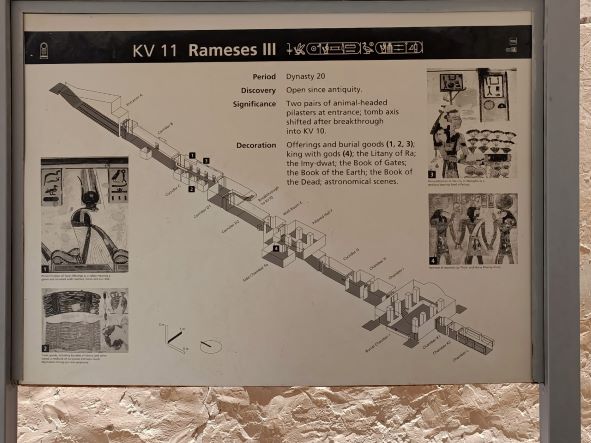The Tomb of Rameses III in the Valley of the Kings Luxor Egypt | KV11 | Facts, discovery, tomb robberies, Pharaonic Tombs, ancient Egyptian History.
The Tomb of Rameses III
Who is Rameses III 1217 BCE – 1155 BCE? Facts About King Rameses III
Rameses III was the last of the great Pharaohs on the throne of Egypt and the second Pharoah of the Twentieth Dynasty after his father Setnakhte, The New Kingdom of Ancient Egypt.
Pharoah Ramses III is well known for his domestic building program, a consolidation of law and order. His reign marked the beginning of the decline of Ancient Egyptian civilization greatness.
However, starting with the 5th year of his reign, he had to fight the Sea People, Libyans, and the Hittites Empire. His great and remarkably well-preserved Medinat Habu temple is still one of the top Luxor tourist attractions. Besides, his tomb in the Valley of the Kings, KV11 is one of the best things to do in Luxor and a perfect example for a Pharaonic Tombs.
Rameses III was followed by a succession of short-lived kings, all of whom adopted the name Ramesses. But at least we know that Ramesses IV, Ramesses V, and Ramesses VIII seem to be sons of Rameses III.
Where is Rameses III Tomb?
The tomb of Rameses III, KV11 is located in the main Valley of the Kings, Luxor West Bank of the Nile, Egypt. KV11 is side by side with the tomb of Amenmesse (KV10) and almost faces the tomb of Ramesses V, and Ramesses VI(KV9). This Pharaonic tomb of Rameses III was not originally for him, Pharoah Setnakhte started the tomb then Ramesses finished it for himself.
Facts about the King Rameses III tomb KV11, Valley of the Kings, Luxor, Egypt
- Rameses III tomb KV11 in the Valley of the Kings is located in the East Valley of the Kings
- The tomb was not originally his tomb, was Setnakhte’s tomb.
- This tomb is extensive and gorgeous and the paintings and hieroglyphs here are of very high quality
- It is one of the longest in the valley, measuring a total of 180 meters
- It was discovered by James Bruce in 1768.
- Belzoni called the tomb, “Tomb of the Harpists“, due to a bas-relief representation of two blind harpists
- KV11 follows typical plans of the Nineteenth Dynasty’s tombs.
- On both sides of the entrance, there are twin Hathor-headed columns and between them is the standard solar disc with goddesses.
- Litany of Ra, Book of Dead, Book of Gates, and Opening of the Mouth ritual are among the religious books we can spot on the walls of this tomb
- Deceased with deities are common scenes here such as Maat, Ptah, Nefertem, Geb, Khepri, Thoth, and Ra-Horakhty.
Rameses III sarcophagus
- Giovanni Belzoni found the lid of the Red Granite sarcophagus in 1815
- It was sold to the Fitzwilliam Museum in Cambridge
- British Consul, General Henry Salt retrieved the large red granite sarcophagus of King Ramses III
- It was sold to the Louvre Museum in 1823
- So, the conclusion is the sarcophagus is in the Louvre in Paris, the lid in Fitzwilliam Museum in Cambridge, and the mummy was found in the Deir Al Bahri cache and is now in the Egyptian Museum of Civilization.
Who is the discoverer of the tomb of Rameses III KV11?
James Bruce was the first European traveler to enter this tomb in 1768 but it has been known since antiquity. Later, in 1792, William Browne reached the burial chamber for the first time and Belzoni removed the sarcophagus and lid. Belzoni named it the “Tomb of the Harpists”, due to a bas-relief representation of two blind harpists. However, European travelers often referred to the tomb as “Bruce’s Tomb”.
Restoration work in Rameses III tomb
Half of the tomb is under restoration nowadays even the tomb is one of the most visited tombs in the Valley of the Kings.
THE RAMESSES III (KV 11) PUBLICATION AND CONSERVATION PROJECT
Humboldt-Universität zu Berlin in the cooperation with Egyptian Ministry of Antiquities project aims to preserve, document, and publish the tomb of Ramesses III (KV11), situated in the Valley of the Kings.
Due to water damage and thousands of years of degradation processes, the rear part of the tomb has been destroyed heavily. Our aims are to study and conserve the tomb in order to make it fully accessible to the public.

The plan of The Tomb of Rameses III | Tomb Layout
First of all, to reach the tomb of Rameses III at the Valley of the Kings, you need to cross the entrance where they check your ticket. Then, walk straight into the main Valley like 250m, it will be the 2nd tomb on your left-hand side after that of the Sons of Ramses II (KV 5). The layout of the tomb is as follows
- Entryway
- First corridor with two sides chambers on both sides
- 2nd corridor with 8 side chambers facing each other on both sides
- Small chamber
- 3rd corridor
- Well chamber
- Pillared room with one side chamber
- 4th corridor
- 2 small chambers one behind the other
- Burial chambers supported by 8 columns
- 4 side chambers on the four corners of the burial chamber
- 3 chambers one behind another after the burial chamber
MEASUREMENTS
- Maximum height: 6.55 m
- Minimum width: 0.75 m
- Maximum width: 13.86 m
- Total length: 113.93 m
- Total area: 726.34 m²
- Total volume: 2174.29 m³
DECORATION of the tomb of Rameses III
- Painting
- Sunk relief
- Graffiti
Things found inside the tomb
- The Red Granite Sarcophagus
- The Lid of the sarcophagus
- a wooden shabtis
- Tomb equipment
- Vessels
Tomb Robberies at the End of the New Kingdom
Tomb robbing in ancient Egypt was recognized as a serious problem since antiquity. The Tomb of Tutankhamun gave us a perfect example of what we can find inside a royal tomb. That was the reason why the tombs were targeted for tomb robberies right after burying the kings. Merenptah’s tomb was one of these tombs and all the tomb treasures were totally stolen by the thieves of the cemetery.

The inscriptions & decorations | Tomb reliefs
- On both sides of the entrance and to the right and left of the side walls, there are two columns ending with human faces and cow ears most probably goddess Hathor of love, protection, and motherhood.
- There are two Greek graffiti on the left wall
- On the left wall, we can see the Pharaoh Rameses III in front of Ra-Horakhty then the beginning of the Litany of Ra. Moreover, the sun disc and inside it a scarab and a ram-headed god between a serpent and a crocodile. The same scene can be found above the entrance of the Merenptah tomb.
- On the right wall is the continuation of texts of the Litany of Ra.
- This corridor has two Greek graffiti on the right wall and two Hieratic graffiti on the left wall
- The second corridor has 8 small chambers, 4 on each side.
- The walls of the corridor are decorated with the Litany of Ra, with scenes from the Book of the Dead, spell 151.
- We can spot Anubis once with Goddess Isis and once with Goddess Nephthys to the east and west wall.
- The ceiling is decorated with a sun disc inside it the ram-headed God and Isis and Nephthys are depicted as hawks flanking that disc.
- Two Greek graffiti on the left wall and one Demotic graffiti on the same wall
- On the left wall of that room, we can see Pharoah Rameses III offering incense to Atum and the receive the Heb-Sed Festival symbol from Ptah.
- A beautiful scene for the Pharoah Rameses III offers incense and libation to Ptah-Sokar and a winged Isis.
- Ramesses offered Maat to Osiris and libation to Anubis
- Two Greek graffiti on the left wall and one Demotic graffiti on the same wall
- 3rd corridor has the fourth on the left wall and the fifth hours on the right wall of the Imy dwat
- Well, shaft room is decorated with many Gods figures such as Osiris, Imsety, Anubis, Duamutef, Isis, and Iwnmutef on the left wall. While the right wall has figures for Osiris, Hapy, Qebehsenuef, Nephthys, Serqet, and Iwnmutef.
- There are 12 Greek graffiti on the left wall and only 3 graffiti on the right wall
- 4 Pillared room with one side chamber to the right side. The side chamber is decorated with the fourth division, the fifth hour of the Book of Gates.
- One of the pillars has hieratic graffiti dating back to the 21st Dynasty and another one on the right side
- Nowadays this is the last opened part of the tomb and the rest is closed for restorations.
- The corridor after the pillared room is decorated with scenes showing the Opening of the Mouth ritual.
- The next room is decorated with 20 gods and goddesses’ figures holding scepters in shrines, with small offering tables placed in front of them
- The next chamber is in very condition preservation and the scenes show 4 groups of gods or ‘demons
- The burial chamber is supported by 8 columns and a curved ceiling connecting the 8 gods who create the world.
- 4 small chambers on the 4 corners are decorated with scenes from the Book of the Dead, Book of Gates, and Book of the Earth.
- On the pillars, the Pharoah makes offerings in front of many gods such as Atum, Thoth, Ra-Horakhty, Horus, Osiris-Wennefer, Soped, Anubis, Ptah-Tatjenen, Geb, Ra, Ptah-Sokar-Osiris, Shu, and Onuris.
- Inside the burial chamber, Belzoni found the Lid and the sarcophagus.
- The next square room is in very bad condition
- Again, the following square room is partly discovered and shows only deities
- The last corridor with3 small chambers on the right wall and two on the left hand and scenes show the Book of the Gates with the judgment hall of Osiris.

Visiting Hours of KV11?
As long as the tomb of Rameses III is one of the Valley of the Kings’ tombs, the visiting hours to the tomb are the same as the opening hours of the Valley of the Kings. Valley of the kings is open daily from 06.00 am to 17.00 pm but ticket windows close at 16.30 pm. That means you can visit the tomb daily between 06.00 am to 17.00 pm.
How much is Rameses III tomb ticket?
kindly put in your mind that you will need to purchase two tickets. Entrance ticket for the Valley including access to 3 tombs and a ticket for the electric car. Ticket windows are next to each other. The entrance ticket includes 3 opened tombs and nowadays Rameses III’s tomb is included in the ticket. This means, no extra charge for this tomb.
Tips for visiting the tomb of Rameses III
- The first piece of advice we can tell, visit the valley of the Kings and the tomb of Rameses III with an archaeologist guide. They will provide you with a detailed explanation of the development of the tombs from the Predynastic period till the New Kingdom. Meanwhile, detailed information about the Pharaonic tombs and ancient Egyptian history during the New Kingdom.
- Read before you go to enjoy more
- Take extra water with you and some snacks, especially in the summer months, and drink at least 5 small bottles of mineral water to not hydrate.
- Small change for the WC(5 L.E) per person
- Do not forget to take your hat, sunglasses, and suncream with you
- Cotton dress during summer
- There is a café facing king Tutankhamun tomb in the valley of the kings if you like to drink something or have an ice-cream
Kindly Note:
That was a brief idea about the tomb of one of the ancient Egyptian Pharaohs and an example of one of the Pharaonic tombs in the Valley of the Kings. If you like to visit more Pharaonic tombs and learn more about the best things to do in Luxor, Egypt Palma Tours highly recommends Luxor Tours to
- KV2 The Tomb of Ramesses IV
- KV6 The Tomb of Ramesses IX
- KV11 The Tomb of Ramesses III
- KB 8 Merenptah tomb
- KV 14 Tausert and Setnakht
If you like to know about the best tombs you can visit against the charge, here are the three extra ones
- KV9 – Ramesses V, Ramesses VI
- KV17 – Seti I
- KV62 – Tutankhamun tomb
That was about the Valley of the Kings and the Pharaonic tombs but if you like to know more about Egyptian history when booking Luxor Day Trip from Sahl Hasheesh, ancient Egyptian civilization, and Pharaonic temples, we recommend the following sites


Comment (0)